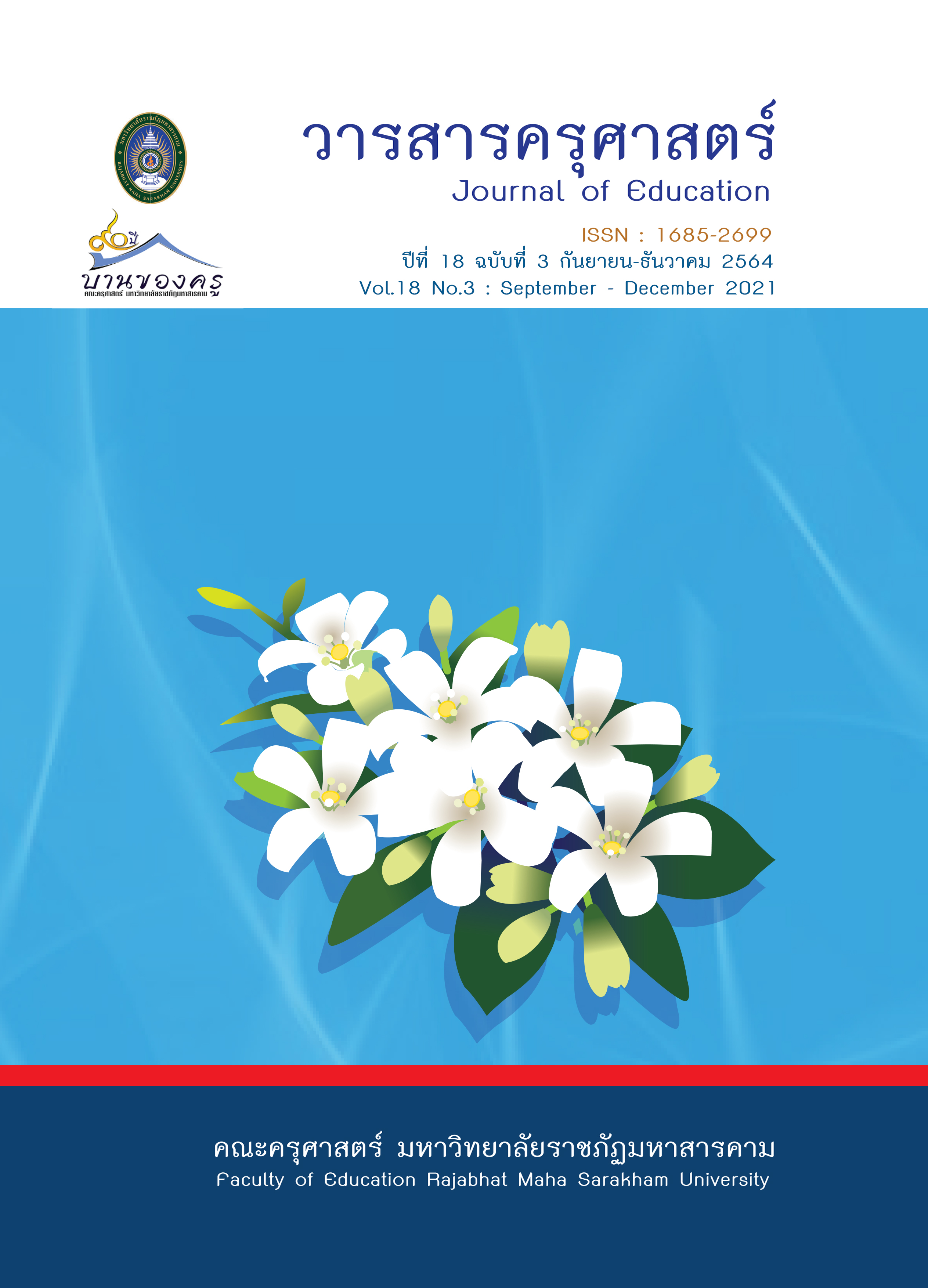The Achievement and Satisfaction of Thai Students upon Learning Management of Mandarin through Kahoot Application
Main Article Content
Abstract
The objectives of this paper were 1) to study the achievement in Mandarin learning management before and after the use of Kahoot of first-year students majoring in Chinese program at Suratthani Rajabhat University. and 2) to study the satisfaction on Mandarin learning management using Kahoot of first-year students majoring in Chinese program at Suratthani Rajabhat University. The sample included one section of 20 first-year students, in semester one of academic year 2020. The study was an experimental study using one group pretest – posttest design
The research findings were 1) the students’ achievement in Mandarin learning management pretest was 53.00 percent and posttest was 71.43 percent. The analysis based on the teaching Chinese framework of the academician, the researcher found that the posttest score of using Kahoot on Mandarin synonyms (近义词) and sentence structures “verb +了” of the sample was not considered a good level. 2)The satisfaction on Mandarin learning management using Kahoot of the students showed that the enjoyment was in the highest level ( = 4.28, S.D. = 0.890), followed by the use of the program ( = 4.27, S.D. = 1.044), and the benefits ( = 4.12, S.D. = 1.158), respectively. In addition, the analysis of the interview on the satisfaction of Mandarin learning management showed that the students were most satisfied with the enjoyment.
Article Details

This work is licensed under a Creative Commons Attribution-NonCommercial-NoDerivatives 4.0 International License.
ข้อกำหนดเบื้องต้นที่ผู้นิพนธ์(ผู้ส่งบทความ) ควรทราบ
1. ผู้นิพนธ์ที่ประสงค์จะลงตีพิมพ์บทความกับวารสาร ตั้งแต่เดือนมกราคม 2563 เป็นต้นไป ให้ใช้รูปแบบใหม่ (Template 2563) โดยสามารถดูตัวอย่างได้ที่เมนู GUIDELINES
2. จะตีพิมพ์และเผยแพร่ได้ ต้องผ่านการประเมินจากผู้ทรงคุณวุฒิ (Peer Review)
3. การประเมินบทความโดยผู้ทรงคุณวุฒิ (Peer Review) เป็นแบบ Double Blind
4. การอ้างอิงบทความใช้หลักเกณฑ์ APA (American Psychological Association) คลิก
5. บทความถูกปฏิเสธการตีพิมพ์ ไม่ผ่านการประเมิน ผู้นิพนธ์ขอยกเลิกเองหรือชำระเงินก่อนได้รับการอนุมัติ ทางวารสารไม่มีนโยบายการคืนเงิน
References
เกรียงศักดิ์ ฐานะกอง และนิธิดา อดิภัทรนันท์. (2560). การใช้กิจกรรมการสอนภาษาเพื่อการสื่อสารเพื่อเพิ่มพูน
ความสามารถในการฟัง-พูดภาษาอังกฤษและความรู้ด้านไวยากรณ์ของนักศึกษาระดับปริญญาตรี. วารสารศึกษาศาสตร์ มหาวิทยาลัยนเรศวร. 19(4), 51-64.
ฝ่ายวิชาการสำนักพิมพ์ แมนดาริน. (2561).คู่มือการเรียนการสอนภาษาจีน. แมนดาริน.
ทวิวัฒน์ วัฒนกุลเจริญ. (2556). การประเมินคุณภาพการเรียนการสอนชุดวิชาสื่ออิเล็กทรอนิกส์และโทรคมนาคม
ทางการศึกษา สาขาวิชาศึกษาศาสตร์ มหาวิทยาลัยสุโขทัยธรรมาธิราช. วารสารศึกษาศาสตร์มสธ, 6(2), 93-104.
เธียรชัย เอี่ยมวรเมธ. (2553). พจนานุกรมจีนไทย ฉบับใหม่. (พิมพ์ครั้งที่ 24-25). รวมสาส์น.
นงรัตน์ อิสโร. (2561). ยุทธศาสตร์มหาวิทยาลัยราชภัฏเพื่อการพัฒนาท้องถิ่น ระยะ 20 ปี. กระทรวงศึกษาธิการ.
นพธร ปัจจัยคุณธรรม. (2559). การฟังและการพูดภาษาจีน 1. มหาวิทยาลัยรามคำแหง.
พร้อมเพื่อน จันทร์นวล และนิภาพร เฉลิมนิรันดร. (2560). การจัดการเรียนรู้โดยใช้เกม Kahoot เพื่อพัฒนาผลการ
เรียนรู้วรรณคดีไทย. วารสารศึกษาศาสตร์ มหาวิทยาลัยศิลปากร, 15(2), 92-100.
ยุวดี ถิรธราดล. (2553). การพัฒนารูปแบบการเรียนการสอนภาษาจีนตามทฤษฎีการรับรู้ความสามารถของตนเอง
และการเรียนรู้ด้วยตนเองเพื่อเสริมสร้างความสามารถทางการพูดภาษาจีนของนักศึกษาปริญญาบัณฑิต.
{วิทยานิพนธ์ปริญญาครุศาสตร์ดุษฎีบัณฑิต ไม่ได้ตีพิมพ์}. จุฬาลงกรณ์มหาวิทยาลัย.
รุจาภา เพชรเจริญ และวรสิทธิ์ เจริญศิลป์. (2561). การประเมินการใช้ Kahoot Program ในการจัดการเรียนการสอน
ผ่านเครือข่ายการสอนทางไกล Telemedicine. วารสารครุพิบูล มหาวิทยาลัยราชภัฏพิบูลสงคราม. 5(2), 162-175.
วรวัติ กิติวงค์. (2561). เตรียมสอบครูผู้ช่วยในสังกัด สพฐ. ฉบับครบเครื่อง.(พิมพ์ครั้งที่ 3). ธิงค์ บียอนด์ บุ๊คส์.
วัลภา คงพัวะ. (2562). การศึกษาความพึงพอใจที่มีต่อการใช้ Kahoot! ในการจัดการเรียนรู้ของนักศึกษาระดับ
ปริญญาตรี สาขาวิชาการจัดการ มหาวิทยาลัยนอร์ทกรุงเทพ ศูนย์การศึกษานนทบุรี. วารสารวิชาการ
สมาคมสถาบันอุดมศึกษาเอกชนแห่งประเทศไทย ในพระราชูปถัมภ์ สมเด็จพระเทพรัตนราชสุดาฯ สยามบรม
ราชกุมารี, 25(1), 116-132.


